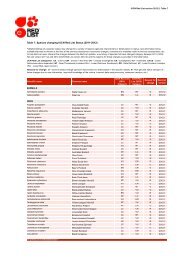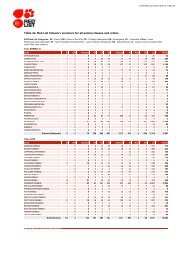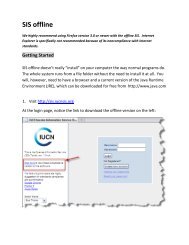IUCN Red List Guidelines - The IUCN Red List of Threatened Species
IUCN Red List Guidelines - The IUCN Red List of Threatened Species
IUCN Red List Guidelines - The IUCN Red List of Threatened Species
You also want an ePaper? Increase the reach of your titles
YUMPU automatically turns print PDFs into web optimized ePapers that Google loves.
<strong>Red</strong> <strong>List</strong> <strong>Guidelines</strong> 34<br />
distance”.) <strong>The</strong> value <strong>of</strong> α can be chosen with a required level <strong>of</strong> resolution in mind. <strong>The</strong><br />
smaller the value <strong>of</strong> α, the finer the resolution <strong>of</strong> the hull. Experience has shown that an α<br />
value <strong>of</strong> 2 is a good starting point for some species (however, the value to use for specific<br />
cases <strong>of</strong> assessing reductions in EOO should be based on a compromise between minimizing<br />
the potential bias associated with incomplete sampling <strong>of</strong> outlying occurrences and<br />
minimizing the departure from a convex hull). This process results in the deletion <strong>of</strong> lines<br />
joining points that are relatively distant, and may subdivide the total range into more than<br />
one polygon. <strong>The</strong> final step is to calculate the extent <strong>of</strong> occurrence by summing the areas <strong>of</strong><br />
all remaining triangles. When this exercise is repeated to estimate EOO from a second<br />
temporal sample <strong>of</strong> points (and hence assess change in EOO), the same discontinuity<br />
distance between points should be used as a threshold for deleting lines (rather than the same<br />
value <strong>of</strong> α). This will reduce bias due to variation in sampling effort between the two surveys<br />
and the bias due to changing average line length with more or fewer occurrences.<br />
Extent <strong>of</strong> occurrence and area <strong>of</strong> occupancy are measures <strong>of</strong> the current distribution, i.e. they<br />
should not include areas where the species no longer exists. On the other hand, these<br />
measures should not only include the actually known sites, but also inferred sites. For<br />
instance, sites can be inferred from presence <strong>of</strong> known appropriate habitat, but where the<br />
species has not yet been searched for. In doing so, it will be important to judge to what extent<br />
the taxon has been looked for. Incorporating inferred sites results in a range <strong>of</strong> plausible<br />
values, which may give a range <strong>of</strong> plausible <strong>Red</strong> <strong>List</strong> Categories (see sections 3.1 on Data<br />
availability, inference and projection, and 3.2 on Uncertainty).<br />
4.10 Area <strong>of</strong> occupancy (criteria A, B and D)<br />
“Area <strong>of</strong> occupancy is defined as the area within its 'extent <strong>of</strong> occurrence' (see 4.9 above),<br />
which is occupied by a taxon, excluding cases <strong>of</strong> vagrancy. <strong>The</strong> measure reflects the fact<br />
that a taxon will not usually occur throughout the area <strong>of</strong> its extent <strong>of</strong> occurrence, which may<br />
contain unsuitable or unoccupied habitats. In some cases, (e.g., irreplaceable colonial<br />
nesting sites, crucial feeding sites for migratory taxa) the area <strong>of</strong> occupancy is the smallest<br />
area essential at any stage to the survival <strong>of</strong> existing populations <strong>of</strong> a taxon. <strong>The</strong> size <strong>of</strong> the<br />
area <strong>of</strong> occupancy will be a function <strong>of</strong> the scale at which it is measured, and should be at a<br />
scale appropriate to relevant biological aspects <strong>of</strong> the taxon, the nature <strong>of</strong> threats and the<br />
available data (see below). To avoid inconsistencies and bias in assessments caused by<br />
estimating area <strong>of</strong> occupancy at different scales, it may be necessary to standardize estimates<br />
by applying a scale-correction factor. It is difficult to give strict guidance on how<br />
standardization should be done because different types <strong>of</strong> taxa have different scale-area<br />
relationships.” (<strong>IUCN</strong> 2001)<br />
Area <strong>of</strong> occupancy (AOO) is a parameter that represents the area <strong>of</strong> suitable habitat currently<br />
occupied by the taxon. As any area measure, AOO requires a particular scale. In this case,<br />
the scale is determined by the thresholds in the criteria, i.e. valid use <strong>of</strong> the criteria requires<br />
that AOO is estimated at scales that relate to the thresholds in the criteria. <strong>The</strong>se scales (see<br />
“Problems <strong>of</strong> scale” below) are intended to result in comparable threat status across taxa;<br />
other scales may be more appropriate for other uses. For example, much finer scales are<br />
appropriate for planning conservation action for plants, and larger scales may be appropriate






